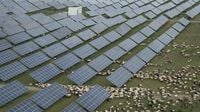High on the windswept Tibetan plateau, a transformation is underway that could reshape the global energy landscape. On August 22, 2025, Chinese government officials unveiled a bold vision: what they say will soon be the world’s largest solar farm, sprawling over 610 square kilometers—roughly the size of Chicago. As reported by the Associated Press, this ambitious project underscores China’s rapid ascent as the world leader in solar power installation and signals a new chapter in the country’s efforts to curb carbon emissions.
It’s not every day that a nation sets out to build a solar farm so vast that it rivals the footprint of a major American metropolis. Yet, that’s exactly what China has announced on the Tibetan plateau, a region known for its high elevation, abundant sunshine, and challenging terrain. According to Associated Press coverage, Chinese officials showcased the site in August, offering a glimpse of a future where clean energy dominates the skyline, rather than coal-fired smokestacks.
Why here, and why now? For China, the Tibetan plateau offers an ideal combination of geography and sunlight. With its expansive, open land and high altitude, the region receives more solar radiation than almost anywhere else in the country. This makes it a prime candidate for large-scale solar development—a fact that hasn’t gone unnoticed by policymakers in Beijing, who are racing to meet increasingly ambitious emissions targets.
The numbers are staggering. The planned solar farm will blanket 610 square kilometers, a scale that’s difficult to visualize. Imagine the city of Chicago—its neighborhoods, parks, and skyscrapers—all covered in shimmering solar panels. That’s the size of the project China is now undertaking. As reported by the Associated Press, this isn’t just a feat of engineering; it’s a statement of intent from a nation that has long been the world’s leading emitter of greenhouse gases.
But China’s investment in solar isn’t just about breaking records. It’s about results. In recent years, the country has been installing solar panels at a pace that far outstrips any other nation. According to both the Associated Press and other outlets reporting on the August showcase, this rapid expansion is finally starting to pay off. Emissions, once thought to be on an unstoppable upward trajectory, are beginning to fall as clean energy comes online at scale.
“China has been installing solar panels far faster than anywhere else in the world, and the investment is starting to pay off,” noted Ken Moritsugu and Ng Han Guan in their Associated Press dispatch. The message is clear: after years of warnings about China’s growing carbon footprint, there are now signs that the tide may be turning—at least when it comes to the power sector.
This latest project isn’t happening in isolation. It’s part of a broader push by the Chinese government to meet its own ambitious climate goals. As highlighted in reports from August 21 and 22, the new solar farm is explicitly tied to the country’s commitment to reduce emissions and transition to renewable energy. The effort is nothing if not urgent: China has pledged to peak its carbon emissions before 2030 and achieve carbon neutrality by 2060, a timeline that leaves little room for delay.
For years, critics have questioned whether China could reconcile its rapid economic growth with environmental stewardship. After all, the country’s meteoric rise has been fueled in large part by coal, with vast power plants churning out electricity for factories, offices, and homes. But as the economic calculus shifts and the costs of climate change become more apparent, Beijing has begun to pivot—investing heavily in renewables, electrifying transportation, and, as this project shows, betting big on solar.
The Tibetan plateau project is a vivid illustration of this new approach. While the technical challenges are significant—building and maintaining a solar farm at high altitude is no small feat—the potential rewards are enormous. Not only does the plateau receive some of the highest levels of solar radiation in China, but its vast, sparsely populated expanses mean that large-scale installations can be built with minimal displacement of people or disruption to existing land use.
Of course, questions remain. How will China integrate such a massive influx of solar power into its national grid? Can the country maintain the pace of renewable energy deployment needed to meet its climate commitments? And what impact will projects like this have on local communities and the fragile ecosystems of the Tibetan plateau? For now, Chinese officials are projecting confidence, emphasizing the project’s role in meeting emissions targets and showcasing it as a symbol of national progress.
“The project is part of China’s efforts to meet emissions targets,” reported outlets covering the August announcement. That’s a straightforward statement, but it carries weight. With the world watching and the stakes higher than ever, China’s ability to deliver on its promises could shape the trajectory of global climate action for decades to come.
It’s worth noting that China’s solar ambitions extend far beyond the Tibetan plateau. Across the country, from the deserts of Xinjiang to the rooftops of Shanghai, solar panels are being installed at a record pace. According to the Associated Press, the cumulative effect is starting to show: emissions are falling, and China’s energy mix is gradually shifting away from fossil fuels.
For international observers, the scale and speed of China’s solar push are both impressive and instructive. In an era when many countries are struggling to make meaningful progress on climate, China’s willingness to invest at this level demonstrates what’s possible when political will and economic resources align. Of course, challenges remain—not least the need to balance development with environmental protection and to ensure that local communities benefit from the transition to clean energy.
Still, the unveiling of the world’s largest solar farm on the Tibetan plateau marks a milestone not just for China, but for the global effort to address climate change. As the panels go up and the emissions come down, the world will be watching closely to see what comes next. Will this be the tipping point that accelerates the shift to renewables worldwide? Or just another headline in the long, complicated story of humanity’s relationship with the planet?
One thing is certain: the sun is rising on a new era of Chinese energy, and the world’s largest solar farm is just the beginning.




